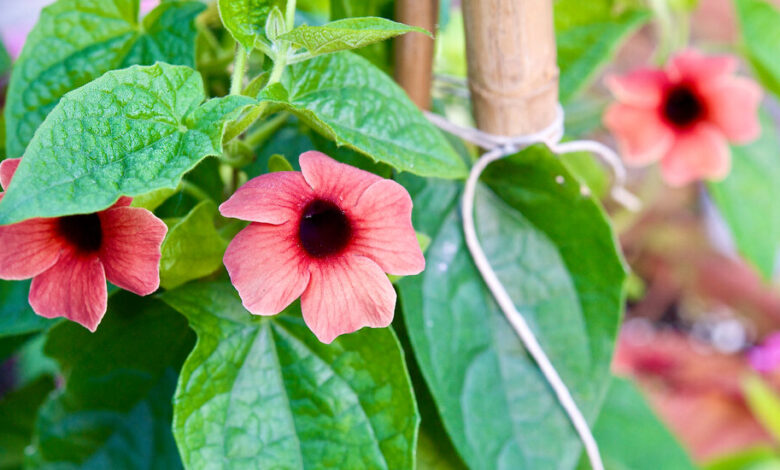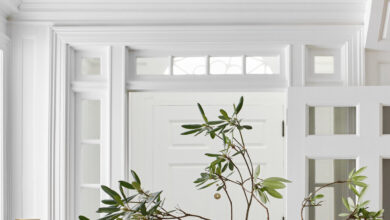Annual Vines Can Transform Your Garden in a Single Season. Here’s How.

[ad_1]
In Matt Mattus’s garden and greenhouse, analysis and artistry are as closely intertwined as the annual vines that represent just one of his many botanical passions.
On the one hand, Mr. Mattus has a trial gardener’s mindset — or, at least, that of a disciplined curator, ever looking to weed out the vines that don’t measure up and showcasing only the finest. He doesn’t merely dabble in a genus; he dives in headfirst.
Not content to sample a sweet pea or two, he once ordered dozens of Lathyrus species and varieties from an English seed catalog so he could grow them side by side, compelled to make his own assessment — and maybe discover an overlooked standout.
But Mr. Mattus was also a graphic artist and toy designer at Hasbro for many years, so he brings an artist’s sensibility to his gardening, constantly conceiving garden scenes.
He conducts his experiments in a two-acre garden surrounding the 1906 house in Worcester, Mass., where he was raised, and where he and his partner, Joe Philip, have lived for almost 25 years. It was once Mr. Mattus’s grandfather’s house, and his father was born there; both previous generations gardened there, too.
These days, there is always something being collected for study, including an assortment of fancy-leaf begonias (“Can anyone really have too many?”) and at least as many lilies. (“How many are enough? I really don’t know yet,” Mr. Mattus mused, acknowledging that the lilies’ fragrance is “nearly too strong” indoors if he isn’t judicious about his bouquet making.)
One recent growing season, he conducted a trial of about a dozen flowering-tobacco varieties (Nicotiana). Yes, the catalog descriptions note distinctions, he allowed, but “I like to see them all together.”
Seeing — and taking notes — is believing. And it’s how garden and gardener grow.
Morning Glory Cousins and Malabar Spinach
Each winter, Mr. Mattus scans the catalogs for his next subject of exploration, and for candidates to satisfy his longtime craving for vines — most of them tender perennials from Central and South America, grown in temperate gardens as annuals. Besides color, they add architecture, quickly manifesting living walls or punctuating the place with botanical exclamation points.
One is more delightfully curious looking than the next. We may all recognize a classic Heavenly Blue morning glory, but what about its distinctive cousins in the genus Ipomoea, all of them hummingbird favorites?
The flashy Spanish flag (I. lobata), adorned with what look like ombré strings of tiny pennants, ranks among his top five annual vines. The vivid red cardinal climber (I. x multifida) and the nearly look-alike cypress vine (I. quamoclit), which has much finer-textured foliage, are charmers, too. And then he found the pink- and the white-flowered versions of cypress vine, which he simply had to try.
Mr. Mattus currently has his eye on a new-to-him selection of Ipomoea luteola, called Sunspots, in the vine-rich Select Seeds catalog, which has scaled-down, yellow-throated scarlet trumpets. How will it compare? Next summer will tell.
And while Malabar spinach (Basella rubra) may be listed among the vegetables, Mr. Mattus’s appetite for experimentation inspired him to sow it in a big pot fitted with a columnar tomato tower. “That was one of my hero moments this year,” he said. “I planted it just to see what it would do.”
It quickly covered the support with hot-pink vines bearing big, glossy green leaves and bead-like, pinkish-white flowers.
Next year? “I want to do a row of them in the driveway,” he said.
Which Support for Which Plant?
Vines, Mr. Mattus has come to understand, are not so different from us: They do better when the right support is offered.
In a twist on “right plant, right place,” he said, they are most successful when their morphology is considered in determining an appropriate climbing structure. One style doesn’t fit all.
First consideration: Does a particular vine twine like a morning glory, wrapping its stems around its support, or does it cling with tendrils, like sweet peas? Most annual vines do one or the other.
“Think pole beans versus peas,” he said, conjuring a familiar visual. The twiners are somewhat more adaptable.
More than one gardening friend has lamented to him that sweet peas planted alongside a wooden trellis panel never ascended. Vines with tendrils like that do best when there are finer-textured elements to grab onto, like netting or twiggy brush.
Even among all the sweet peas, though — the only vining plant that Mr. Mattus, a self-described “sweet-pea geek,” included in his 2020 book, “Mastering the Art of Flower Gardening: A Gardener’s Guide to Growing Flowers, from Today’s Favorites to Unusual Varieties” — some are better on particular supports, he said. It depends on whether your goal is a garden display or cut flowers.
The Finer Points of Sweet Peas
When incorporating sweet peas into a bed design, Mr. Mattus prefers to use antique varieties like Painted Lady, Flora Norton or America, which have slightly smaller, ruffled flowers.
Let them scramble over a “sort of geodesic dome,” he suggested, formed of twiggy branches “bent down into a half-bubble,” inspired by Clematis he saw grown that way in England.
Even simpler: Fashion tripods of brush, then give the young plants a little help with a piece of string or two in the early weeks, to empower their ascent.
For cut flowers, though, he favors the larger-flowered Spencer types, trained on bamboo to promote long stems. To support them, he anchors parallel rows of eight- or 10-foot canes into the ground, about eight inches apart within each row, and then tethers the rows together with a bamboo crossbar near the top.
Although any of these sweet peas could be direct-sown like edible peas in early spring, Mr. Mattus starts his in the greenhouse — you could also try a cool indoor room under lights — about six weeks before a late-April outdoor transplant target date. He sows the seeds in extra-deep small pots or plug-tray cells to encourage their substantial roots. Pinching out the second or third set of leaves that form prevents lanky, weak growth.
With the cut-flower Spencers, a bit of twine is required, over and again, to secure their way up the bamboo poles. Repeated removal of the tendrils is needed, too, so they don’t disfigure the flowers or stems.
The payoff: several weeks of fragrant, late June or July bouquets.
Window Boxes and Pots of Vines
Another consideration when choosing an annual vine is its eventual height. Some grow too rampantly, a lesson Mr. Mattus learned the year he planted Cobaea campanulata, an obscure relative of the charming cup and saucer vine (Cobaea scandens), in the window boxes on one side of the house.
“It covered the windows, like we had shades on them,” he said. “Even the porch screen door was engulfed.” Cross that one off the list.
He does plant the comparatively more manageable C. scandens, but in the ground alongside the porch, because even it is capable of growing up to 20 feet from seed in a season.
Black-eyed Susan vine (Thunbergia alata) has proved a better choice for those window boxes. It also starts blooming earlier, for an extended display. To guide the vines, use twine — or, better still, rubber-coated electrical wire — stringing it between eye hooks positioned around the windows.
Thunbergia comes in vivid sunset colors with contrasting eyes and one that is white with a black center. It is great in pots, too, as are various climbing nasturtiums (Tropaeolum majus), another early-to-flower choice.
With the potted vines, Mr. Mattus is not stingy with support. Rather than the typical tripod of three canes for each container, he inserts a bamboo cane every four inches around the pot circumference, wiring them together at the top.
The finished containers are his “portable towers of color,” he said. Flanking a path, perhaps, a row of them forms “a phalanx of vine-covered teepees.”
Most annual vines don’t ask much beyond a short head start in cells or three-inch pots. Cobaea, or any morning glory or nasturtium relative, is sown in May in the greenhouse or under lights. The vines, he said, are “up like gourds in a few days, and in maybe two weeks they’re outside.”
Two slower-to-germinate vines rate late-February indoor starts in a warm spot, including his top choice of all, the purple bell vine (Rhodochiton atrosanguineus). On the surface of a three-inch pot, he sprinkles the fine seed, dividing and repotting each seedling after it has about four leaves. Trailing snapdragon (Asarina scandens, now Maurandya) gets the same treatment.
There is one complicated vining relationship that Mr. Mattus nevertheless finds irresistible: love in a puff (Cardiospermum halicacabum). He describes it as “a mass of crazy hair” that eventually decorates itself with “what look like Christmas ornaments” — big chartreuse pods (i.e., the puffs).
To tame that wild child into a work of art, juxtapose it against a formal element, he advised.
“If you’re just planting it to climb on your porch or arbor, I think you’ll be disappointed; it will look like a weed,” he said. “If you put it in a Guy Wolff pot, though, it’s going to look like a gestural sculpture.”
Margaret Roach is the creator of the website and podcast A Way to Garden, and a book of the same name.
For weekly email updates on residential real estate news, sign up here.
[ad_2]
Source link






